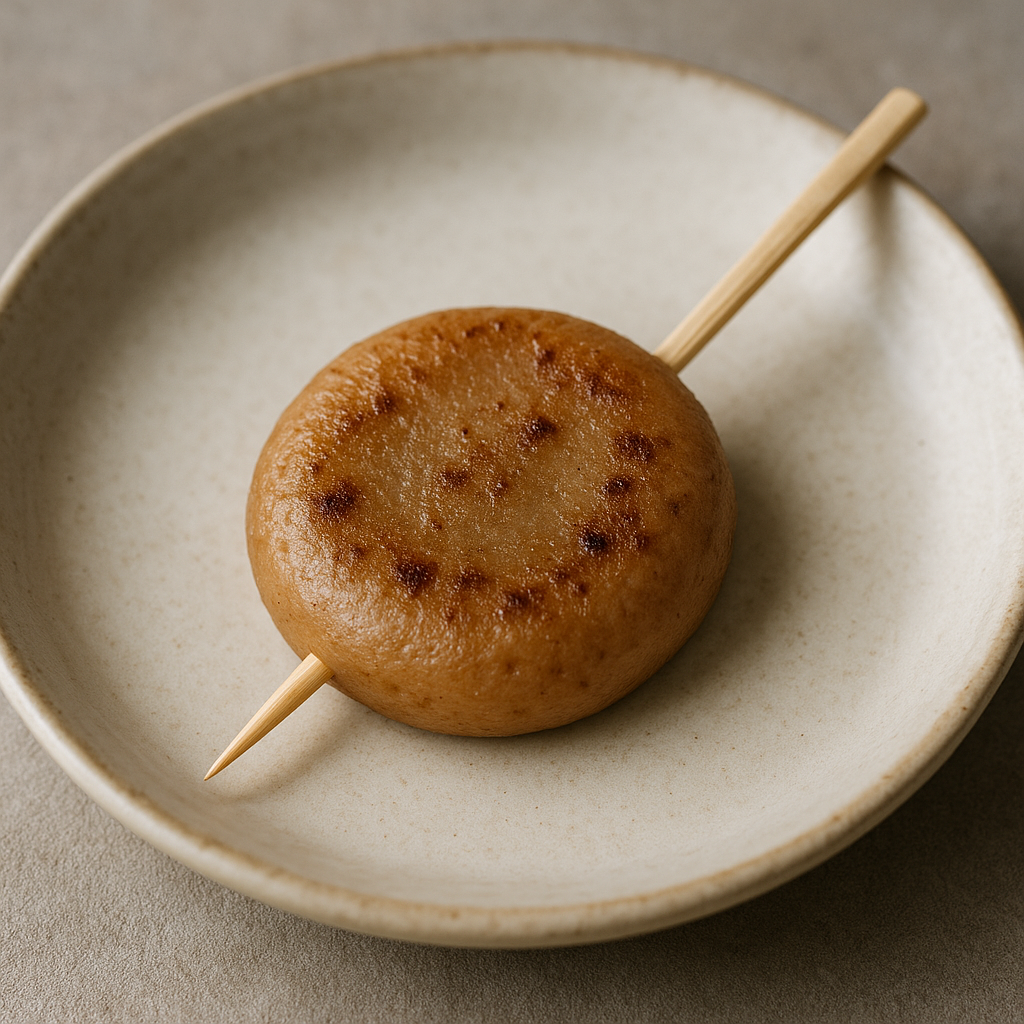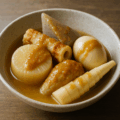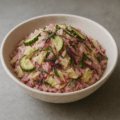じゅね餅の特徴
香ばしい“えごま(じゅね)”餡でいただく郷土餅
じゅね餅は、炒ってすりつぶしたえごま(地域名:じゅね)に砂糖や醤油(または味噌)を合わせた餡を、つきたての餅や切り餅にからめる素朴なおやつ。香ばしさとコク、ほんのり甘じょっぱさが後を引きます。
“じゅね=えごま” 北東北に根づく呼び名
北東北ではえごまを「じゅね」「じゅうねん」と呼び、餅や和え物、味噌(じゅね味噌)などに広く用いてきました。香味油料としての利用が古く、日常から行事まで幅広く親しまれています。
行事にも、日常のおやつにも
年取りや彼岸、祭礼の折にふるまわれるほか、日常の“お茶うけ”としても定番。つきたての餅にたっぷりと絡めて楽しみます。
じゅね餅のレシピ
材料(4人分/切り餅8切れ分目安)
- 切り餅 … 8個(またはもち米 2合)
- えごま(じゅね) … 80g
- 砂糖 … 50〜70g(好みで調整)
- 醤油 … 小さじ1〜2(または味噌 小さじ1)
- 塩 … ひとつまみ
- 熱湯 … 60〜90ml(餡ののびで加減)
- (好みで)みりん … 小さじ1/白ごま 少々
作り方
- 煎る:えごまをフライパンで弱〜中火で乾煎りし、ぷちっと香りが立ったら火を止める(焦がさない)。
- する:すり鉢で油がにじむまでよくする(7〜8割が細かくなればOK)。
- 餡を作る:砂糖・塩・醤油(または味噌)を加え、熱湯を少しずつ注ぎながら緩めのペーストに調整する。
- 餅を用意:切り餅は焼くか茹でる(または電子レンジで柔らかく)。茹で上げは湯をよく切る。
- 和える:温かい餅を餡に入れ、手早く全体にからめる。器に盛り、好みで白ごまをひと振り。
シェフのワンポイントアドバイス
- えごまは香りが立つ直前で火を止めるのがコツ。焦がすと苦味が出ます。
- 餡はやや緩めに仕上げると餅になじみやすい。冷めて固くなったら熱湯を数滴ずつ足して調整。
- 甘さ・塩気は行事向けはやや甘め、日常向けは控えめに。味噌を使うと風味がぐっと深まります。
栄養価(1切れの目安/切り餅1個+餡)
- エネルギー:約180〜220 kcal
- たんぱく質:3〜4 g
- 脂質:6〜9 g(えごま由来)
- 炭水化物:30〜35 g
えごまは香りとコクに加え、α-リノレン酸などの脂質を含みます。餡の量でカロリーと風味を調整できます。
歴史
山里の油料作物としての“えごま”と餅文化
寒冷地で栽培しやすいえごまは、油や香味として活用されてきました。餅と合わせる「じゅね餅」は、行事食・ふるまいとして地域に根づき、家庭ごとに甘さや塩加減、醤油/味噌の配合に個性が受け継がれています。
English Version
Features of Jūne Mochi (Egoma Rice Cakes)
A homestyle mochi coated with fragrant egoma paste
Jūne mochi pairs freshly pounded or warmed rice cakes with a paste made from toasted, ground egoma (perilla seeds—called “jūne” locally), sweetened with sugar and seasoned with a touch of soy sauce (or miso). Nutty aroma, gentle richness, and a lightly sweet–savory finish keep you reaching for another piece.
“Jūne” = egoma, a Northern Tōhoku staple flavor
Across Northern Tōhoku, egoma is known as “jūne” or “jūnen” and appears in mochi toppings, dressings, and jūne miso. Long valued as a flavoring oilseed, it shows up in both everyday fare and festive spreads.
For rituals and for everyday tea-time
Served at year-end, equinox, and festival tables, yet just as common as a cozy snack at home—best with mochi still warm and soft.
Recipe
Ingredients (serves 4 / about 8 pieces)
- Kirimochi (cut rice cakes) … 8 pieces (or glutinous rice 2 cups to pound fresh)
- Egoma (perilla seeds) … 80 g
- Sugar … 50–70 g (to taste)
- Soy sauce … 1–2 tsp (or miso 1 tsp)
- Salt … a pinch
- Boiling water … 60–90 ml (to loosen the paste)
- (Optional) Mirin … 1 tsp / White sesame … a little
Instructions
- Toast: Dry-toast egoma over low–medium heat until the seeds pop lightly and release aroma; do not scorch.
- Grind: In a mortar, grind until the oils begin to emerge (about 70–80% finely ground).
- Make the paste: Add sugar, salt, and soy sauce (or miso). Add boiling water little by little to form a loose, glossy paste.
- Prepare the mochi: Grill, boil, or microwave the rice cakes until soft; drain well if boiled.
- Coat: Toss the warm mochi in the paste to cover evenly. Plate and, if you like, sprinkle a touch of white sesame.
Chef’s Tips
- Stop toasting just before the seeds darken—bitterness comes quickly if overdone.
- A slightly loose paste clings best to mochi; if it tightens as it cools, whisk in a few drops of hot water.
- For celebrations, go a touch sweeter; for everyday snacks, reduce sugar. Using miso deepens savory aroma.
Nutritional Value (per piece: 1 kirimochi + paste)
- Calories: ~180–220 kcal
- Protein: 3–4 g
- Fat: 6–9 g (from egoma)
- Carbohydrates: 30–35 g
Egoma adds aroma and body, and provides fats including alpha-linolenic acid (ALA). Adjust paste quantity to balance flavor and calories.
History
Egoma as a mountain oilseed and the mochi tradition
Well suited to cool climates, egoma was long pressed for oil and used as a seasoning. Jūne mochi became a beloved regional sweet and ceremonial offering, with each household fine-tuning sweetness, saltiness, and soy/miso balance in its own way.



何でも質問してください!